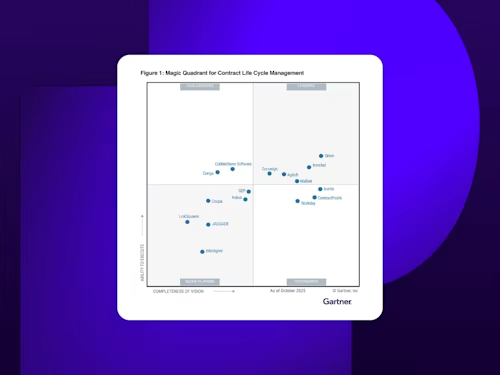
Tariffs Impact: 8 Important Clauses to Check for in Your Supplier Agreements
Businesses must proactively review supplier agreements to navigate the complexities of tariffs. Key contract clauses like force majeure, price adjustment, and country of origin details need careful examination to ensure flexibility and mitigate risks. Docusign Navigator can help procurement and legal teams identify and act on critical terms, providing visibility and agility when responding to shifting trade policies.
- 1. Force majeure clauses
- 2. Price adjustment clauses
- 3. Duration, renewal terms, and termination for convenience
- 4. Country of origin details
- 5. Payment terms
- 6. Volume commitments
- 7. Escalation or dispute resolution clauses
- 8. Service level agreements (SLAs)
- Navigate tariff turbulence with Intelligent Agreement Management
Table of contents
- 1. Force majeure clauses
- 2. Price adjustment clauses
- 3. Duration, renewal terms, and termination for convenience
- 4. Country of origin details
- 5. Payment terms
- 6. Volume commitments
- 7. Escalation or dispute resolution clauses
- 8. Service level agreements (SLAs)
- Navigate tariff turbulence with Intelligent Agreement Management

The current economic climate presents significant challenges for procurement teams. Fluctuating policies and shifting trade dynamics mean businesses must be ready to respond to changes in hours, not months.
In times like these, agreements become a powerful anchor. They house the terms that can shield your organization—or leave it exposed. To safeguard budgets and ensure compliance, procurement and legal professionals need to stay agile, reviewing current and future supplier agreements as conditions change.
Ideally, your contracts should provide:
Flexibility: Mechanisms to renegotiate unfavorable terms in response to changing conditions.
Accountability: Leverage to ensure vendors meet their obligations.
Compliance Assurance: Clarity to navigate a fluctuating regulatory landscape.
From agreement revisions to supplier renegotiations, there’s a long list of to-dos on your plate. To help you get started, we’ve pulled together this checklist of important contract clauses that should be on your radar—and how to turn them from cost drivers into strategic levers.
1. Force majeure clauses
While force majeure clauses typically cover events like natural disasters or even supply chain disruptions, contract protections can start to blur once trade restrictions enter the picture. When tariffs aren’t clearly addressed in force majeure clauses, suppliers have opportunities to argue they’re no longer obligated to perform when costs spike or delivery timelines slip. That could leave you with limited legal grounds to push back.
Actionable insight: To avoid surprises, review whether your vendor contracts include provisions for government-imposed tariffs and how those tariffs are classified, especially regarding force majeure or other performance-related clauses.
2. Price adjustment clauses
Price adjustment clauses are your safety valve when supplier costs spike. Without them, vendors may have no obligation to absorb tariff-related increases, or worse, they might pass them straight on to you with no warning.
Actionable insight: Look for language that allows you to renegotiate pricing if tariffs drive up costs. Strong clauses should clearly outline when adjustments are triggered, how they’re calculated, and which party is responsible for the added expense.
3. Duration, renewal terms, and termination for convenience
Contracts without clear escape routes can lock you into risks you didn’t plan for, like inflated costs, unreliable suppliers, or sourcing strategies that no longer make sense in a tariff-heavy landscape.
Actionable insight: Wherever possible, build flexibility into your agreements, including the ability to renew on favorable terms, pause when necessary, or exit entirely if conditions change. The more agile your contract, the better positioned you’ll be to adapt to shifting markets.
4. Country of origin details
A few lines of vague or inaccurate sourcing language can cost you thousands in unexpected duties or compliance penalties. With CBP enforcement ramping up, even small errors or omissions can turn into expensive penalties. What’s more, a contract that doesn’t clearly define the country of origin puts you at risk of product misclassification, incorrect duty rates, and customs delays.
Actionable insight: To stay ahead, make sure your contracts clearly define where goods are sourced. The more precise your sourcing terms, the better equipped you’ll be to respond when trade rules shift and make smarter sourcing decisions when the landscape shifts.
5. Payment terms
Unclear or outdated payment terms can leave you on the hook for unexpected duties, freight surcharges, or currency fluctuations you didn’t budget for. And if the contract doesn’t clearly spell out who’s responsible for what, you might end up covering more than your fair share. Rigid terms only make it worse. Even a modest spike in costs can create serious cash flow pressure when there’s no room to adjust.
Actionable insight: Look to clauses that incorporate clear and flexible payment terms to stay ahead of rising costs. When your contract allows for deferral or renegotiation, it’s easier to manage surprise invoices without putting a strain on cash flow. Just as important, well-defined terms make it clear when payments are due, who’s responsible for extra costs, and how to handle disruptions.
6. Volume commitments
What seemed like a smart volume commitment six months ago might not look so attractive after a tariff hike. If demand drops or prices surge, being locked into fixed quantities can turn into a major liability.
Actionable insight: Check how much flexibility your agreements give you to scale orders up or down. Contracts that allow for volume adjustments—or at least open the door to renegotiation—enable you to be responsive when market conditions shift.
7. Escalation or dispute resolution clauses
When costs spike, even the strongest supplier partnerships can hit a rough patch. Whether it’s through a formal escalation process, third-party mediation, or arbitration, your vendor contracts should outline how disagreements will be handled—and how quickly.
Actionable insight: To avoid disruptions and strained relationships, make sure your agreement includes clear response timelines, defined steps for escalating unresolved issues, and provisions for continued performance—such as ongoing deliveries—while a dispute is being resolved.
8. Service level agreements (SLAs)
When tariffs disrupt timelines, costs, or delivery routes, vendor performance standards can start to slip. But SLAs are there precisely to protect you in these situations—and they should remain enforceable when external conditions change.
Actionable insight: Pay attention to language that holds vendors to agreed-upon response times, delivery standards, and quality thresholds, regardless of market volatility. If exceptions are allowed, ensure they’re narrowly defined and time-bound, so temporary disruptions don’t become long-term performance issues.
Navigate tariff turbulence with Intelligent Agreement Management
With a lack of clarity around future tariff policies, procurement teams need to be flexible with clear visibility into their agreements. Docusign Navigator gives your procurement and legal teams the power to identify and act on key terms and clauses quickly and at scale in the event of policy changes.
As a core feature of the Docusign IAM platform, Navigator brings all your vendor agreements together in one searchable hub and leverages AI to automatically track and surface key contract terms, such as renewal dates, SLAs, and payment terms. Give your team the data they need to act quickly in just a few clicks. With key agreement data at your fingertips, you can:
Understand your exposure: Quickly find agreements with suppliers in tariff-impacted areas and flag terms like price increases, pass-through costs, or price caps.
Identify what’s urgent: Filter agreements by renewal date, value, or region to focus on the ones that require action now.
Spot risks and levers: Look for terms like force majeure or early termination to identify areas of flexibility and areas where you're exposed.
React quickly, together: Share reports with your cross-functional partners so everyone stays aligned and acts quickly.
We can’t predict what trade policy will look like in the future. But one thing is clear: organizations that can surface key terms and insights within a moment’s notice will be the ones best positioned to act. See how better agreement visibility can help you assess risks, act with agility, and stay in control.
Schedule a custom demo to explore how Docusign IAM and Navigator can support your procurement and legal teams—no matter what the market throws your way.
Related posts
Docusign IAM is the agreement platform your business needs




